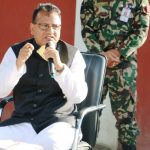By Dr Hemant R Ojha
The Issue
If Bijaya Subedi, a forest officer in Nepal’s Department of Forest is right in his calculations, the old growth forest in the country’s low-lying area of Terai can generate a revenue of about US Dollar 300 million every year if managed actively. This amount will be many times higher than the combined value of current annual revenues collected by the Government and benefits received by the communities living near the forest. If managed actively, Terai forests can also generate thousands of jobs for youths migrating out to the Middle East for menial jobs. But to realise such benefits, he argues, we need to undertake ‘scientific forest management’ (SFM) – a practice that requires foresters to design and implement tree cutting and regeneration schemes, typically under the aegis of a state forest agency. Perhaps officials like Subedi have a new vision of how SFM can happen and benefit the society – a vision that looks different from the past history of bad forest governance surrounding the practice of SFM both in Nepal and internationally.
A seasoned community forestry activist, Ghan Shyam Pandey, argues that scientific forestry does not have a good history – as the state forest agency in the name of science has excluded people from forest use and management in the past. Ganesh Karki, the chair person of the Federation of Community Forestry User Groups (FECOFUN), argues that SFM has harboured corruption around sale of timber. These activist challenges to SFM needs serious attention. There are indeed some irrefutable critiques of SFM globally by critical social scientists, democracy activists and community rights campaigners , invoking a variety of problems associated with SFM, from centralised control to timber monoculture. But problems in the past does not mean it is not worthy to explore possibilities in the new situation. As Subedi demonstrates, non-management of Terai forests is a huge loss to people, the nation and the society at large.
Policy contradictions
It is good that a new debate has started on how Nepal can get most out of its forests. Amidst such debates, Nepal’s Parliamentary Committee on Environment has instructed the Ministry of Forest and Soil Conservation not to proceed with SFM activities. It instructed the Ministry to ‘stop cutting trees in the name of scientific forest management”. The Ministry and its Department of Forest have the plan to roll out SFM models across Terai, primarily under Collaborative Forest Management, an approach involving the joint control of communities and the government. Unhappy with the new parliamentary committee decision, officials at the Ministry are now trying to justify their plan for upscaling SFM practice which they say has been tested and ready for wider implementation. Wider forest science community has also reacted to the Parliamentary decision, labelling the policy move as unscientific, unfounded and unhelpful to the people of Nepal.
All of this debate is about many large block forests in the Terai, which occupies about one-fourth of the country’s area and host about half of the 30 million people who live in highly heterogeneous communities of diverse socio-cultural groups. There is still about 0.5 million hectares of productive forest area, most of which is old growth high value Sal forests, in need of human assistance for regeneration. In the case of hills, Nepal has gained international reputation for its successful program on community forestry, which started in the wake of Himalayan crisis in the late 60s. Over 17 thousand Community Forest Groups are empowered to manage the small patches of forest totalling 1.7 million hectares, with limited prospect for intensive management and market oriented management. These forests are used mainly for the subsistence purpose and are often located in the remote areas. These areas therefore have attracted hardly any attention in terms of scientific management, production and marketing of the forest products.
The debate for and against SFM has become intense also due to the changing political context of Nepal. As the country enters a period of peace after prolonged conflict, and as the two giant neighbours India and China become enormous market for natural products, the Nepal forestry sector has now seen an unprecedented boom in the market for forest products. Besides, Nepal being one of the fastest urbanising societies in South Asia, there has been a steep rise in the demand for timber, which is met through increasing timber imports. Amidst this situation, the Director General of Forest Department argues for the need of scientific forest management so that Nepal need not spend hard-earned remittance money to import timber from outside, while waste stretches of forests remain idle at home, due to limited progress on scientific forest management.
Need to link science with democracy
In my view, ‘scientific forest management’ is not a bad idea, but it can be good only when we consider three questions underlying SFM: 1) SFM by whom?; 2. SFM for whom?; and 3) SFM through what kinds of institutions and partnership? Asking these questions take us to a new conceptual terrain of what I call ‘democratic forest governance’ – which emphasises the need to find answers to the above three questions, in order to be able to practice the idea of scientific/sustainable/effective forest management.
The first question is about defining the roles of communities, local governments, national government agencies as well as other players such as professional associations, research groups and community federations. The second question is about benefit and cost sharing – who should receive what proportion of the benefits resulting from the management of forests. The third question is about sharing power and responsibility among diverse actors – and crafting a right institutional framework. Currently, we have more than eight different modalities of forest governance – community forestry, collaborative forest management, buffer zone community forestry, community conservation areas (such as Annapurna Conservation Area model), protected areas, government-managed forests and so on. These modalities offer rights to either local communities or national government agencies, and there is very limited role of local government (partly because of the lack of elected local governments for a decade now). And even when there is a clear legal arrangement for defining rights, disputes continue in practice.
All this means that SFM cannot be envisioned in a political vacuum. Democratic forest governance means that we address the political questions and scientific questions together. Political questions also include the kind of institutions, forms of partnerships, framework of accountabilities and mechanism of representation – surrounding the decisions and practices of forest management. When we only talk about scientific forest management, we ignore such underlying political questions. If we proceed with SFM without considering democratic governance, we are likely to end up with further controversies, confusion and conflicts. This is particularly likely in view of the past failed attempts of ‘scientific forest management’ over the past six decades. Indeed, the notion of ‘scientific forest management’ itself has a politicised history – favoured by some and opposed by others.
In such situation, invoking scientific forest management without a concurrent initiative to foster democratic forest governance will not succeed. To reiterate, I am not against scientific forest management – I am indeed in favour of it, but only when the three governance questions are also addressed or at least considered at the same time. I believe that if we address governance questions, we create a better ground for scientific forest management by engaging communities, local governments, civil society, and business groups.
Making robust policy decisions
I must say here that I do not subscribe to the orthodox and elitist view of ‘science’ – I think there is nothing more scientific than a situation in which all contesting actors come together to find an agreeable solution. In the Terai forest case, we need to reconcile the interests of people living around the forest, people living in Madhesh but not necessarily close to forests, local governments and people of the distant locations in the country (such as remote mountainous district of Humla where people need Sal timber to construct hydro-power dams, perhaps in exchange for the the electricity to the people of Terai). We also need to account for the interests of the future generation.
But I admit that these are not easy to accomplish, and I am not quite optimistic about the immediate possibility of deepening the practice of democratic forest governance and then catalysing scientific/sustainable/effective forest management. What is critical is how initiatives at different domains of governance emerge and come together, eventually leading to the transformation of Terai forest governance. When I say transformation, I mean creating and amending provisions at constitutional, legal, and regulatory domains, as well as catalysing action on the ground. Transformation also requires collaborative forums of diverse stakeholders at different levels to debate, nurture and innovate solutions.
It is also important that both the parliamentary committees and the high level authority at the Ministry of Forest make policy decisions on forest management strategy only after careful scrutiny of science, community voices, and a careful judgement of consequences on social justice of their decisions. Decision makers should feel privileged that there is so much information, experience and ideas in the Nepal’s forest sector – accumulated over the past five decades of lively debates and field experimentations. Instead of making a decision and reverting it when challenged by science and voice, it is useful to engage openly with scientific community and local people. I can’t understand why public decisions are made on such an ad hoc basis. Policy makers need to demonstrate an willingness and commitment to engage with affected communities, scholarly groups and the public at large. This can be a step towards democratic forest governance to catalyse scientific forest management.









